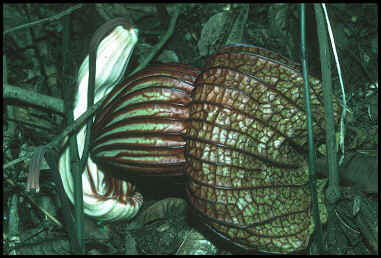Western Cameroon Projects: MOUNT CAMEROON
MOUNT CAMEROON
Mount Cameroon is the tallest mountain (4095 m) and only active volcano in continental tropical Africa west of the Albertine Rift (Uganda). It is one of the few places where natural vegetation exists from the coast to subalpine elevations and includes one of only three locations (Cape Debundscha) where annual rainfall exceeds 10 m per annum. Kew projects Kew's link with Mount Cameroon began in 1861 when then director William Hooker recommended the Kew Gardener, Gustav Mann, for an appointment as botanical collector in West Africa. Based on Bioco (then Fernando Po, later Macias Nguema), Mann collected many hundreds of high-quality plant specimens at several locations in the Gulf of Guinea over a two-year stay which included three visits to Mount Cameroon. One journey to the upper altitudes of the mountain was made in the company of Alfred Saker (founder of the town of Victoria, now Limbe) and Richard Burton (the famous traveller and writer). Many new species were discovered and published based on these collections (often with the epithet "manniii") principally by Joseph Hooker.A botanic garden was founded in Victoria after Cameroon became a German colony (as "Kamerun") in 1884. After the Great War of 1914-1919, westernmost Cameroon came under British control and RBG, Kew was asked to give advice on the future of the Botanic Garden at Victoria. This link between Kew and Victoria (now Limbe) has continued ever since.
|

Mangrove at Mt Cameroon, continental West Central Africa's highest mountain and only active volcano. Dr Zapfack, orchid specialist from the University of Yaoundé I, is shown collecting specimens. |
 |
In 1986 Kew's Nigel Hepper led a team that visited Mount Cameroon and recommended to the British Governmentthat the Botanic Garden at Limbe be renovated and used as a centre to co-ordinate conservation and education concerning two natural areas on (Etinde) and near (Mabeta-Moliwe) the mountain. What was to become the "Mount Cameroon Project (Limbe)" began with DFID funding in 1988. Kew personnel were heavily involved in advising on the rehabilitation of the botanic garden and herbarium and later on the conducting of botanical inventories and the identification of the relevant specimens. The botanical inventory work culminated in a specimen-based "conservation checklist" of the plants of Mount Cameroon (Cable & Cheek 1998) which built on the earlier "Botanical Inventory of the Mabeta-Moliwe Forest" (Cheek 1992b).
Dr Nouhou Ndam, conservator of the Limbe Botanic Garden, is shown in the herbarium, Cameroon's second largest. Mr Mezili of the National Herbarium, Yaoundé is in the foreground. |
New discoveries
The checklist gives authoritative scientific names, synonymy, geographic ranges and conservation status for the 2438 vascular plant species of Mount Cameroon, defined as an area of about 2700 square kilometres, including the South Bakundu forest and the foothills to the NW and SE of the main massif. Forty-nine of the species are considered strictly endemic, most of which are included in the 116 newly-proposed Red Data species in the book. The last are accepted by IUCN. For each Red Data species about half a page of detailed information is given, including distribution, threats and description.

Pararistolochia goldieana (Aristolochiaceae) with fly-pollinated flowers the size of a cardboard box, this liana is Africa's equivalent of Rafflesia. Photographed inside the Limbe Botanic Garden, it is widespread, though rare, in the forests of Lower Guinea. |
Future work at RBG, Kew includes continued elucidation of the potential new species revealed during previous botanical inventory work and the production of conservation posters for individual threatened species. |
References
Cable, S. & Cheek, M. (1998). The plants of Mount Cameroon, A Conservation Checklist. 279 pp. Kew: Royal Botanic Gardens.
Cheek, M. (1992b). A Botanical Inventory of the Mabeta-Moliwe Forest. Kew: Royal Botanic Gardens, Report to Govt. Cameroon from ODA. 22 pp, provisional check-list (compiled by Cheek, Sidwell, Sunderland & Faruk) 112 pp.

